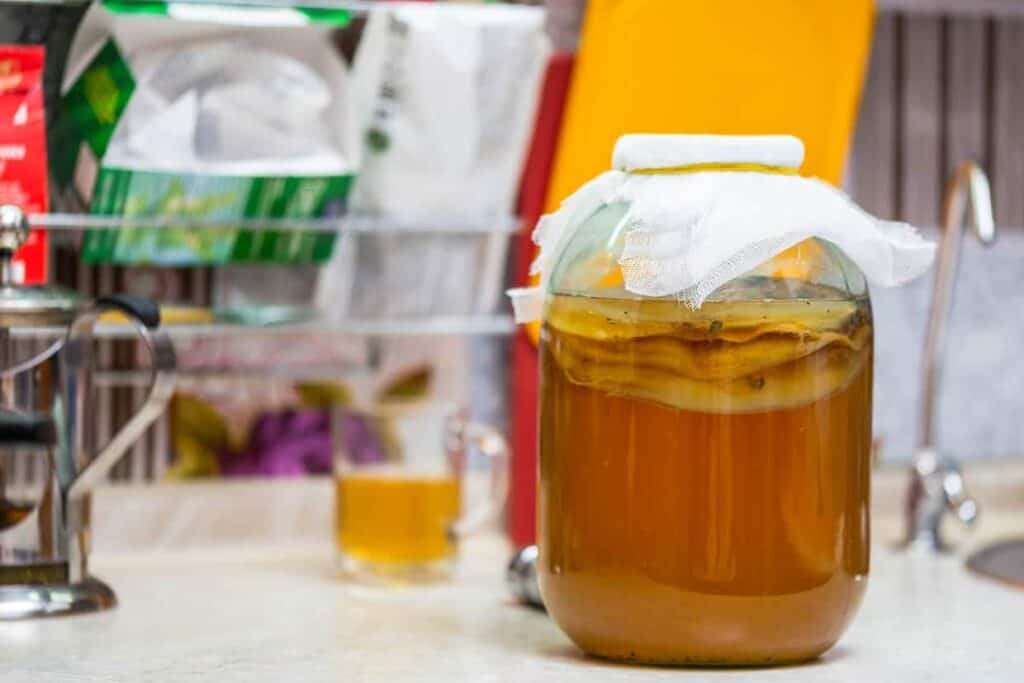Kombucha — a fizzy, fermented tea that has been around for centuries — has exploded in popularity recently. Once you discover how delicious it is, all its health benefits, and how to make kombucha at home, you’ll be ready to join the craze.

If you’re new to the world of kombucha, you’re in for a treat. Kombucha is a fermented tea enjoyed for centuries in many different cultures. Let’s look at what kombucha is, why it’s good for you, and why you should consider making it at home.
What Is Kombucha?
Kombucha is a fermented black tea. To make kombucha, combine tea, sugar, and a SCOBY, which stands for symbiotic culture of bacteria and yeast. The SCOBY eats the sugar and converts the tea into a slightly sweet, tart, lightly carbonated beverage with a unique flavor and a good dose of probiotics and other beneficial properties. Similar to other fermented foods, like miso paste or cheese, the fermentation process adds depth of flavor, and also health benefits.
“I learned about kombucha from my Russian grandfather, who calls it ‘mushroom tea’ and swears by its holistic and nutritional value…. The best part is that while the SCOBY consumes the sugar, it also produces a host of amazing little byproducts, including acetic acid, vitamin C, tea polyphenols, and trace amounts of amino acids. This is why kombucha, known as the ‘tea of immortality’ in Chinese culture, is so good for you!”
— Ksenia Prints, At the Immigrant’s Table
What Does Kombucha Taste Like?
Describing the taste of kombucha is challenging because it is so unique. Generally, kombucha has a slightly sweet and tart flavor, with a bit of vinegar-y funkiness from the fermentation and some effervescence from the natural carbonation.
Depending on the brewing process and added flavors, it can also have a hint of fruitiness or herbal notes. Ultimately, the taste can vary depending on the type of tea used, the brewing time, and any added ingredients, so it’s worth trying a few different types to find your favorite.
Why Is Kombucha Good for You?
Kombucha is praised for its health benefits. Here are some of the top reasons you should consider adding this healthy drink to your diet:
Probiotics: Kombucha is packed with probiotics, which are beneficial bacteria in your gut. These bacteria help maintain a healthy balance of microorganisms in your digestive system. They can improve digestion and boost your immune system.
Antioxidants: Kombucha contains antioxidants, which help protect your body from damage caused by free radicals. Free radicals are unstable molecules that can contribute to aging and disease.
Detoxification: Kombucha has been shown to support liver function and the body’s natural detoxification processes.
Joint Health: Kombucha contains glucosamine, which supports joint health and reduces inflammation.
Energy: Kombucha contains a small amount of caffeine and B vitamins, which can provide a natural energy boost.
“Kombucha is more than just a fermented tea; it’s a refreshing elixir that nourishes your body and soul. With its probiotic and antioxidant properties, it promotes gut health and boosts your immune system,” says Bity Lou of Eighty Recipes. “Making it at home is not only simple and cost-effective, but it also allows you to customize your brew and connect with the ancient tradition of fermentation.”
Why Make Kombucha at Home?
While you can easily buy kombucha at your local grocery store or health food store, there are a variety of great reasons to make it at home:
Cost-effective: Store-bought kombucha can be expensive — anywhere from $3 to $8 or even more per bottle. Making kombucha at home is a cost-effective way to enjoy this delicious drink.
Customizable: You can customize the flavor and sweetness when you make kombucha at home. You can experiment with different types of tea and add fruit, herbs, or spices to create unique flavors. Try adding homemade cranberry juice or fresh mint, for example.
Fun hobby: Like hiking or road-tripping, brewing kombucha can be a fun and rewarding hobby. It’s a great way to learn about fermentation and probiotics while enjoying a delicious and healthy drink.
Eco-friendly: Making kombucha reduces your carbon footprint by eliminating the need for store-bought bottles and packaging.
How To Make Kombucha at Home
Making kombucha may initially seem intimidating, but it’s a simple process. Here are the basics.
Kombucha Making Supplies
Before you can start brewing kombucha, you’ll need a few essential supplies. Here’s what you’ll need:
- A 1-gallon glass jar or container with a wide opening
- A piece of cloth or paper towel to cover the jar
- A rubber band to secure the cloth
- A large pot for boiling water
- A strainer (if using loose tea)
- Organic black tea (you can use caffeinated or decaffeinated)
- Organic sugar
- A SCOBY — you can purchase one online or ask a friend who makes kombucha to share theirs.
- A bottle or bottles with airtight lids.
- A funnel for transferring the kombucha to the bottles.
Brew and Sweeten the Tea
The first step in making kombucha is brewing your tea. Here’s how to do it:
- Boil 4 cups of water in a large pot.
- Add 4-6 tea bags or 4-6 tablespoons of loose tea to the water and steep for 5-10 minutes.
- Remove the tea bags or strain the loose tea and add 1 cup of organic sugar to the hot tea.
- Stir until the sugar dissolves.
- Add 8 cups of cold water to the pot to bring the temperature down to room temperature.
The First Fermentation
Now it’s time to begin the fermentation process.
- Add Your SCOBY. This is the magic ingredient that turns sweetened tea into kombucha. Add it to the glass jar carefully and only after the tea has cooled to room temperature.
- Cover the jar with a cloth or paper towel and secure it with a rubber band.
- Place the jar in a warm, dark place, around 75-85°F, where it won’t be disturbed.
- And now, wait. The fermentation step takes days or even weeks.
What To Expect During Fermentation
Your kombucha will take anywhere from one to two weeks to ferment, depending on the temperature and the strength of your SCOBY. During this time, your SCOBY will eat the sugar in the tea and produce healthy probiotics and enzymes.
You’ll notice bubbles forming on the surface of your kombucha, which means it’s fermenting.
Taste the kombucha after seven days to see if it’s ready. If it’s too sweet, let it ferment for a few more days.
Bottling and Final Fermentation
Once your kombucha is fermented to your liking, it’s time to bottle it up. Here’s how to do it:
- Carefully remove the SCOBY from the jar and place it in a separate container — you’ll save it to make your next batch of kombucha.
- Strain the kombucha into a large bowl or pitcher.
- Pour the kombucha into glass bottles with airtight lids. Use a funnel to avoid spills.
- If you want to add flavor, now is the time. You can add fruit juice, herbs, or spices to the bottle at this point.
- Seal the bottle tightly and let it sit at room temperature for one to three days. This allows the kombucha to carbonate and become fizzy.
- Once it is carbonated to your liking, refrigerate the kombucha. This will stop the fermentation process.
- Enjoy your homemade kombucha!
The Final Word
Kombucha is a delicious and healthy drink that’s easy to make at home. It’s packed with probiotics, antioxidants, and other nutrients that can benefit your health in numerous ways. Making your own is fun, allowing you to enjoy this delicious drink, customize the flavor, and save money.
Whether you’re a seasoned kombucha drinker or a newbie, brewing your own kombucha is a fun and rewarding experience worth trying. So, what are you waiting for? Grab a SCOBY, brew some tea, and get ready to enjoy the many benefits of this delicious drink.
Robin Donovan is the author of more than 40 cookbooks, including the bestselling Campfire Cuisine, Ramen Obsession, and Ramen for Beginners. A food writer, recipe developer, and food photographer, she is the creator of the food blog allwaysdelicious.com, where she shares easy recipes for the best dishes from around the world.
This article originally appeared on Food Drink Life
